How to Do X (Twitter) Sentiment Analysis? 7 Steps
Table of contents
Are you wondering how people are feeling about your brand on Twitter? By monitoring the sentiment of tweets in real time, you can gain insights into what people think and feel about your brand, product, or service. And you don’t need any coding skills to do it!
In this blog post, I’ll show you how to use a Twitter sentiment analysis tool to get instant feedback on the mood of Twitter users.
What is Twitter sentiment analysis?
Twitter sentiment analysis determines whether a tweet is positive, negative, or neutral.
You can do it manually by analyzing each tweet and evaluating whether it is positive or negative. But it is a time-consuming process.
Some tools can do the job for you. Such software can automatically detect the sentiment by analyzing the words used in the tweet and their context.
Here’s an example of a negative Twitter mention:

It’s been classified as negative, as the general feeling of this text expresses negative emotions – here, lack of satisfaction.
And here’s what a positive Twitter mention looks like:

Brand24 is a tool that analyzes the sentiment of Twitter profiles!
Why is it important?
Twitter sentiment analysis is valuable for understanding people’s feelings about a particular topic.
By tracking the number of positive, negative, and neutral tweets about a subject, Twitter sentiment analysis can give you a clear picture of how the target audience feels.
Also, it will help you to:
- Monitor and manage your brand reputation
- Prevent PR crisis at an early stage
- Understand your customers better
- Monitor customer satisfaction levels
- Discover what clients are saying about the competition
- Predict business niche trends
- Find trending Twitter hashtags
Sentiment analysis can be used to make important decisions about marketing campaigns, product development, and more.
Purposes of using Twitter sentiment analysis tools
Twitter sentiment analysis tools are awesome because they help you to understand how people feel about a particular topic, event, or brand.
Twitter is one of the most popular social media platforms and is a great place to get feedback about your product or service.
Twitter users are also more likely to be critical and straightforward than people who leave reviews on other sites. That’s because Twitter users can remain anonymous if they want to.
Sentiment analysis tools are getting better and better at determining the attitude a piece of content expresses. That’s why sentiment analysis is becoming more popular. It finds application in various areas of life:
- Business: companies use opinion mining tools to determine what consumers think of their product, service, brand, marketing campaigns, or competitors.
Here’s a short video that sums up how to use sentiment analysis to find out what your customers like (or dislike) about your company or product:
Speaking of business, believe it or not, this sort of analysis can be used to predict stock market trends!
- Politics: In politics, sentiment analysis is used to keep track of society’s opinions on the government, politicians, statements, and policy changes – or even to predict election results.
On the Internet, you can find studies that Twitter data have been extensively used for sentiment analysis to predict election outcomes worldwide. For example, there is an analysis predicting the Brexit vote by tracking and classifying public opinion using Twitter data.
- Public actions: Opinion analysis is used to analyze online reactions to social and cultural phenomena, for example, Pokemon Go, the premiere episode of the Game of Thrones, or the Oscars.
How to do Twitter sentiment analysis?
There are 2 main ways:
- You can try to do it manually by reading through tweets and categorizing them as positive, negative, or neutral. However, this method is time-consuming and not always accurate. For example, in the last 30 days, Adidas gained over 205k Twitter mentions. Is it physically possible to analyze them all to determine whether they are negative or positive? I don’t think so.
- You can check monitoring tools that can automatically perform Twitter sentiment analysis by using algorithms to assess the emotional tone of tweets. They gather Twitter data, analyze it, and perform sentiment analysis. This software can provide more accurate and timely results than manual methods.
Consider using a social media monitoring tool to minimize the manual labor associated with sentiment analysis.
In addition to Twitter, many social media monitoring tools incorporate sentiment analysis for Facebook, Instagram, and other social media platforms.
Conduct Twitter sentiment analysis with the Brand24 tool!
Twitter sentiment analysis example
To demonstrate how it works, I will analyze the Adidas brand using the Brand24 tool. Let’s check how it performs on Twitter.
Step 1: I created a monitoring project for the “Adidas” keyword. I wanted to find mentions in English, so I selected this language when setting up the project.
Step 2: The tool finds mentions across the Internet, including social media, blogs, news sites, newsletters, forums, reviews, and podcasts. In the last 30 days, there were about 680k mentions of Adidas.
Step 3: I narrowed down the data to Twitter mentions only by setting up a filter.
Step 4: Then, the Mention tab shows the stream of mentions. In the last 30 days, there were 356k mentions. Each is classified as either positive, neutral, or negative.
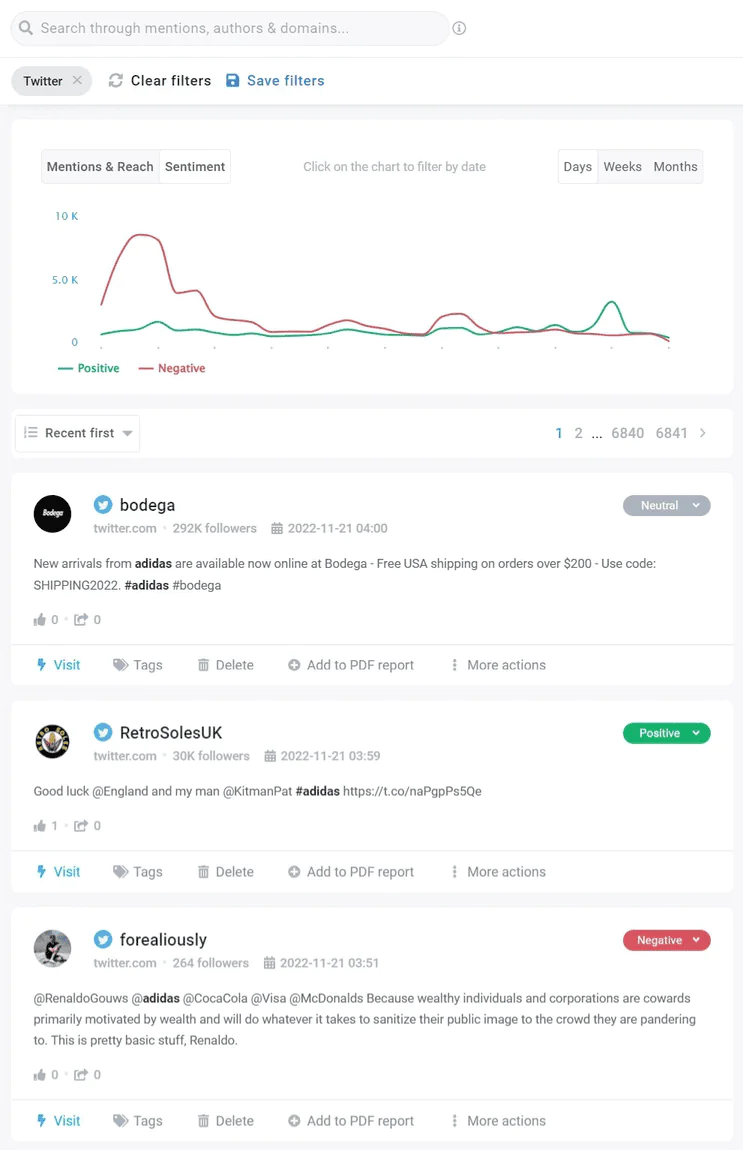
At the top of it, there’s a chart presenting the volume of mentions, their social media reach, the number of interactions, and the number of positive and negative mentions. You can set up the time range in the top right corner.
Step 5: Let’s take a closer look at the chart with a slightly longer time range.
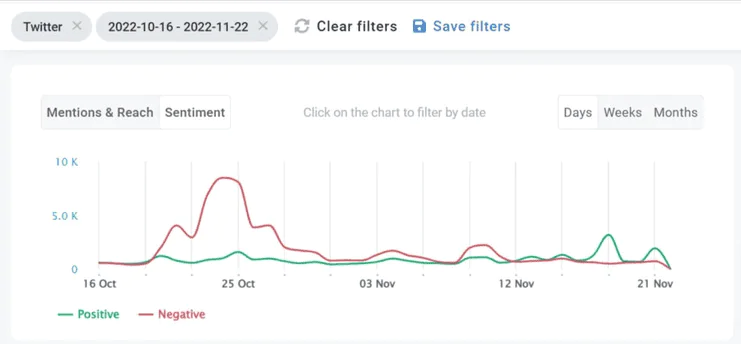
There was a rapid increase in negative mentions. Actually, in a short time, Adidas noted 55k negative mentions. That’s a lot.
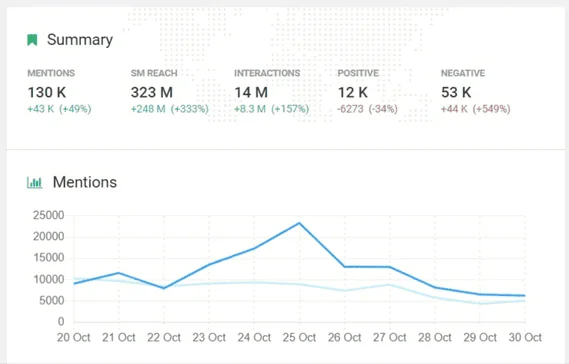
What happened?
Step 6: To find out, I used three filters in the Analysis tab: the time range from 20th to 30th October, Twitter as a source, and negative sentiment.
Thanks to “The most popular mentions” feature, I quickly discovered that people tweet about Kanye West and his controversial beliefs.
As West cooperated with Adidas at that time, it badly impacted the brand’s image.
Most negative tweets were about Adidas breaking its cooperation with the rapper.
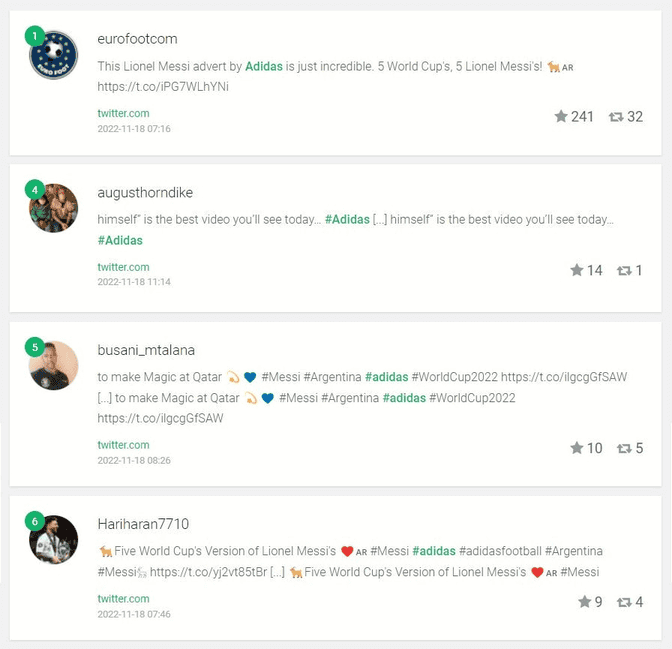
Conduct Twitter sentiment analysis with the Brand24 tool!
The context of the discussion also was related to the partnership with Yeezy. Red words indicate negative sentiment.
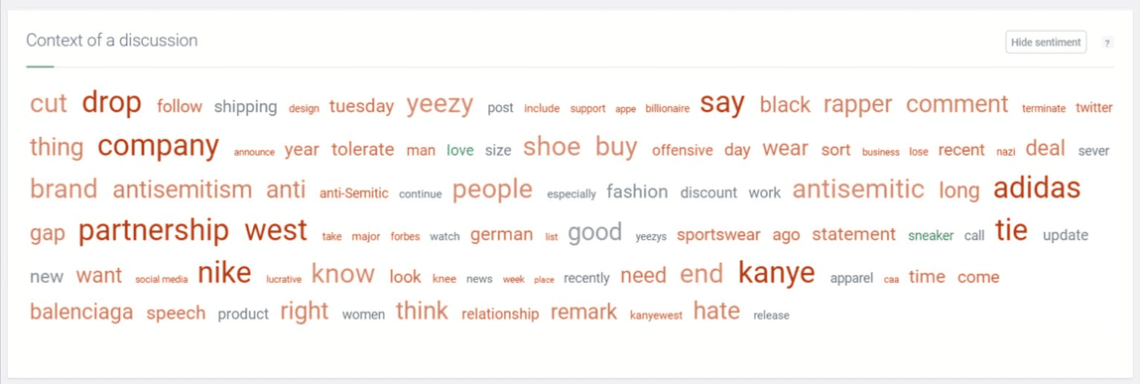
What’s more, most trending hashtags were related to Kanye West.
Such a PR crisis can be harmful. People added the #boycottadidas hashtag to their tweets.
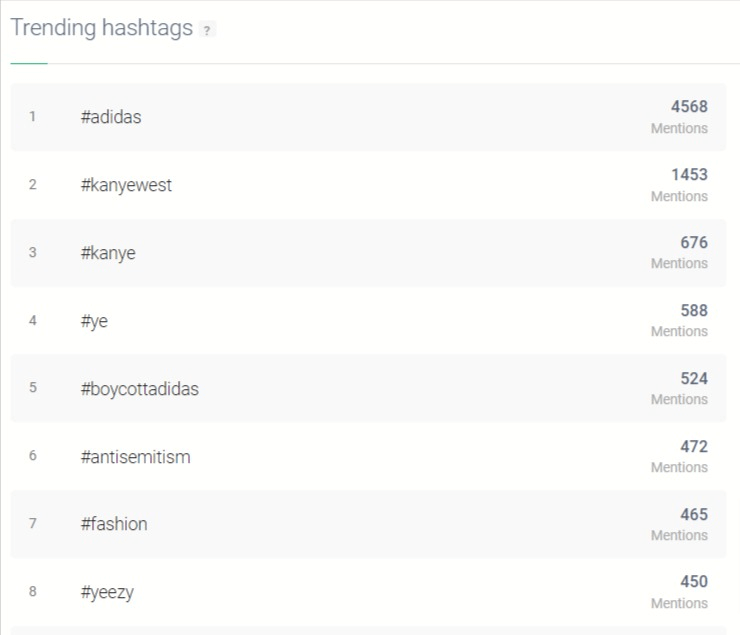
As a result, since 16th October, the Reputation Score of Adidas decreased from 43 to 34.

But, when you look at the chart again, you will notice that on 18th November, there was an increase in positive tweets.

Let’s discover what happened.
Once again, I used three filters in the Analysis tab: data filter on 18th November, Twitter as a source, and positive sentiment.
“The most popular mentions” feature showed me relevant tweets.
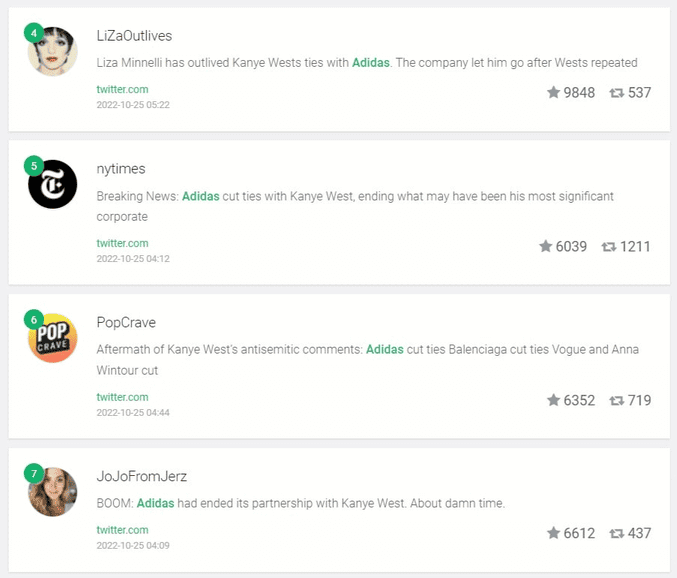
Adidas posted a video ad with five World Cup versions of Lionel Messi. Of course, it went viral immediately.

Step 7: It’s time to compare the sentiments of Adidas and its main competitor Nike.
In the Comparison tab, I set up Twitter as a mentions source. The tool showed me that Nike has slightly more positive sentiment around its brand than Adidas. Also, it gathered about 170k more mentions on Twitter.
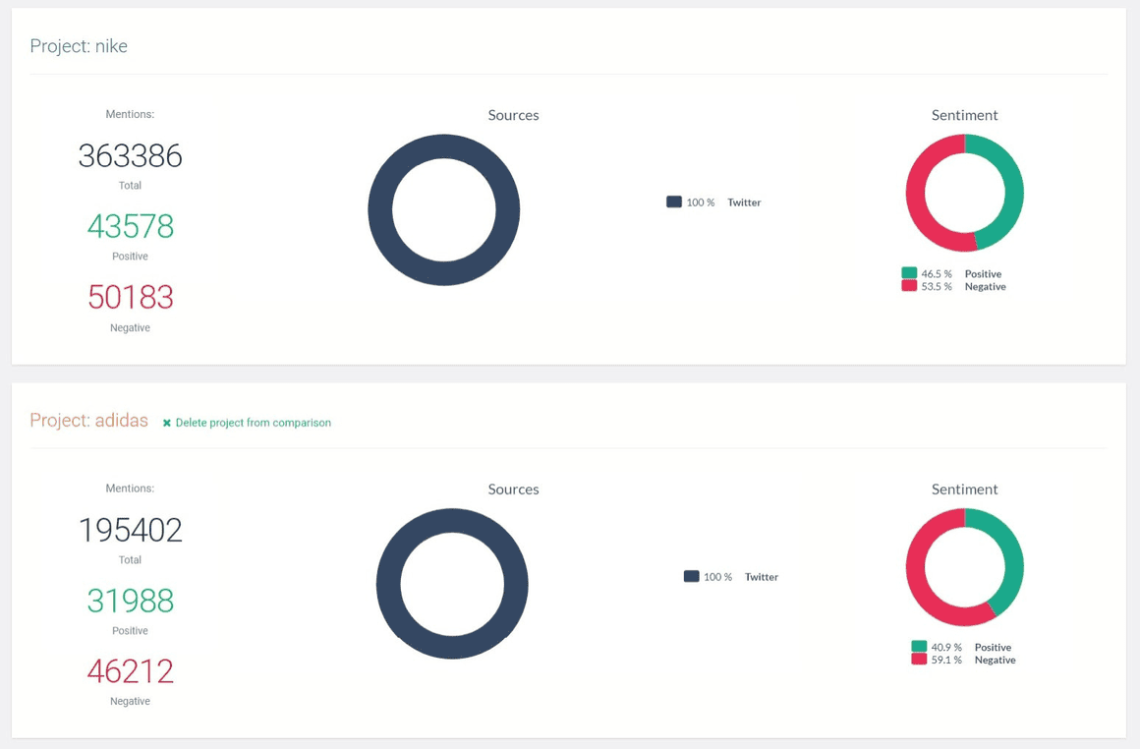
How does Twitter sentiment analysis work?
Each tool has its own sentiment analysis algorithm. Here are explanations of how it works at Brand24 from a technical point of view:
“After project creation, our system starts to collect all mentions with a specified keyword in them. Each of the mentions found is processed through our sentiment analysis model so that the result can be shown in the dashboard. We perform Internet Monitoring and sentiment analysis in real-time to show you meaningful insights as soon as possible.
Our sentiment analysis algorithm leverage the latest advantages of Machine Learning and Artificial Intelligence in general, namely Deep Learning and Pretrained Language Models (PLM), also used by companies like Google, Microsoft, Facebook, and Baidu. This results in the AI capabilities being as close to the real understanding of mentions as possible with the current state of scientific knowledge.
Using tens of thousands of carefully chosen examples, we trained a sentiment analysis model to achieve state-of-the-art quality. This is extremely important for our company to keep our sentiment analysis model as good as it’s technically possible. We’ve designated Data Annotation and Artificial Intelligence Teams, whose primary responsibilities are to take care of its quality and constantly upgrade it.
What’s important, our Twitter sentiment analysis model is language agnostic – which means we’re able to detect the sentiment of mentions written in almost every language spoken on Earth and beyond, with satisfactory quality. We performed innovative research to assess this and published our results at one of the world’s top AI conferences – it is available here.”
Krzysztof Rajda, Head of AI at Brand24
Using sentiment analysis for actionable insights
Once you’ve gathered the data from sentiment analysis on Twitter, it’s time to take action based on those insights.
Here are some ways you can make use of the collected data:
- Address negative feedback – Negative tweets can damage your reputation and hurt your business. If there is a lot of negative feedback about a product or service, it’s essential to address those issues head-on. Reach out directly to those customers and ensure they know their concerns are being taken seriously. Some social media monitoring tools (e.g., Brand24) have storm alert features. So you will be notified whenever there is a rapid change in the mentioned volume.
- Observe what brings positive tweets – By observing the Twitter activity around your brand, you can get a good idea of what people like about your brand. Using social media monitoring is a great way to discover what kinds of content generate positive tweets. This is valuable information on which topics are engaging. For businesses, this can help to inform marketing and customer service strategies.
- Prioritize changes – Use social media sentiment analysis data to determine which areas need improvement first so that you can prioritize changes accordingly. For example, if customers complain about slow shipping times, you should take care of it before any other issue.
- Monitor trends – Use sentiment analysis over time to monitor arising trends and hashtags in customer feedback and respond quickly if needed. This will help ensure that customer satisfaction remains high over the long term.
Conduct Twitter sentiment analysis with the Brand24 tool!
Conclusion
You can easily analyze tweets using a Twitter monitoring tool. In fact, such a tool detects positive and negative tweets automatically. Furthermore, it presents sentiment analysis results in a user-friendly way.
Thanks to sentiment analysis on Twitter, you can:
- Find out what people are saying about your brand or product,
- Discover positive or negative feelings about your brand or product,
- Assess overall customer satisfaction,
- Detect any emerging trend,
- Find trending links and hashtags on Twitter,
- Find the most active Twitter influencers,
- Monitor brand reputation and prevent PR crisis.
Willing to try Twitter sentiment analysis? Sign up for a free trial and test the Brand24 tool!
FAQ
Does Twitter use sentiment analysis?
Twitter itself doesn’t directly provide sentiment analysis, but its API allows developers and third-party tools to collect tweets and perform sentiment analysis on them. This enables the understanding of public opinions and emotions regarding specific topics, brands, or events.
Is Twitter good for sentiment analysis?
Yes, Twitter is an excellent platform for sentiment analysis due to its real-time nature and vast amount of public, concise user opinions. It allows businesses and researchers to gauge public sentiment on a wide range of topics quickly.
How accurate is Twitter sentiment analysis?
The accuracy of Twitter sentiment analysis can vary based on factors like the sophistication of the analysis tool, context interpretation, handling of slang, and language nuances. Advanced tools using Natural Language Processing (NLP) and Machine Learning (ML) can provide a high degree of accuracy.




